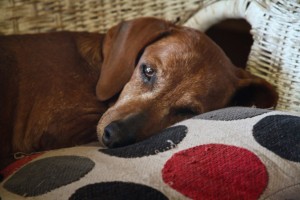Eye injuries are an emergency at Hall Vet Surgery. If your pet has a tightly closed or red eye, with or without a watery or pussy discharge, phone us immediately.
Eye injuries are painful and dogs will rub and damage the eye further if not promptly treated.
Injury to the eye damages the cornea, the clear window at the front of the eyeball.
Blunt trauma, from a grass seed caught under the eyelid, or a laceration like a cat scratch or scratch from a branch or grass are very common causes of corneal injury. Chemicals such as irritating shampoos or sprays may also damage the cornea.
Corneal damage interferes with vision, creates problems deeper in the eye and, if not treated, lead to loss of the eye.
At the Surgery we apply a local anaesthetic and examine the eye for a grass seed or other foreign body under the upper, lower or third eyelids. A fluorescein dye highlights scratches or ulceration of the cornea.
Treatment of corneal injuries depends on the extent of the damage. Superficial corneal damage is treated with antibiotic ointments and pain relief. Surgery or hospitalisation is necessary for deeper injury to protect or repair the eye.


